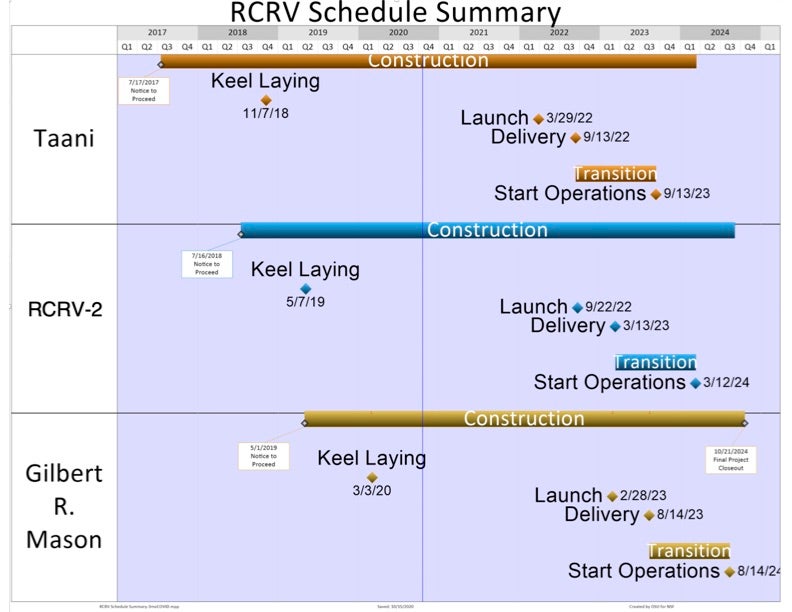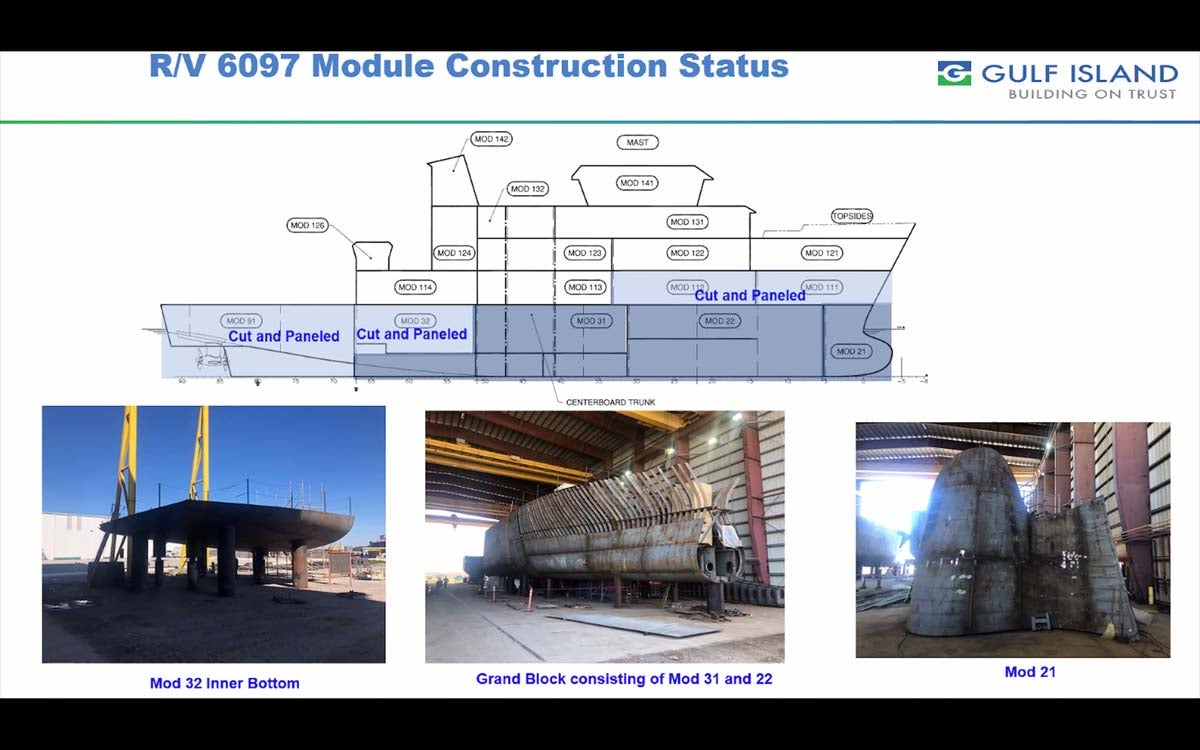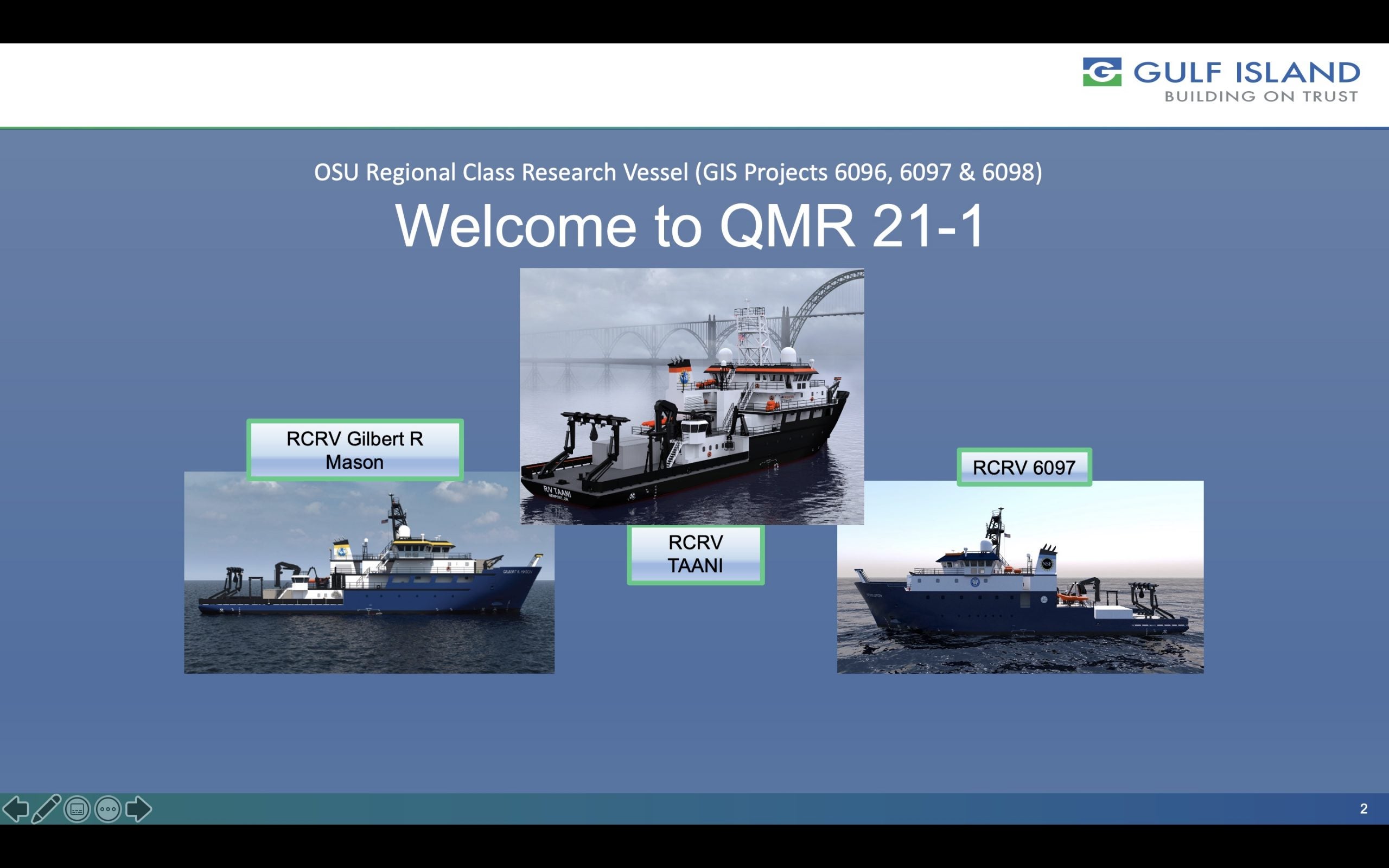RCRV-2 Construction – Interim Report, February 2021
By GSO Dean Emeritus Bruce Corliss
The RCRV project continues to move forward with construction of the R/V Taani, RCRV-2 (Hull 6097), and the R/V Gilbert R. Mason by the Gulf Island Shipyard (GIS) in Houma, La. Last week, a virtual Quarterly Management Review took place with GIS, Oregon State University, who has the NSF contract to build three ships, NSF and the Operating Institutions (OIs) that include OSU, URI, LUMCON and the University of Southern Mississippi. A revised schedule for launch, delivery, and start of operations due to a 4-month delay in ship modeling and design revisions shows the RCRV-2 to be delivered in early 2023 followed by a transit to Narragansett.
The transit will likely include visits to Miami, Puerto Rico and North Carolina to visit East Coast Oceanographic Consortium members as part of an east coast introduction of the new vessel. Following a formal commissioning at GSO, the ship will carry out science trials for up to a year during which time we plan to visit Bermuda (Bermuda Institute for Ocean Sciences), New York City (Lamont-Doherty Earth Observatory, Columbia University), Woods Hole (WHOI) and New Hampshire (UNH).
Ship construction is based on constructing a number of modules. (Watch this PowerPoint in presentation mode to see step-by-step how the vessel is put together.) The initial modules are constructed in enclosed work areas and the hull is then moved to the outside for addition of the remaining modules.
GIS has assembled a number of sub-contractors to assist in the build and they include:
SIEMENS: propulsion and controls, integrated machinery alarms and control system.
Beier Integrated Systems: navigation, internal and external communications, entertainment system, satellite communications, pilothouse consoles.
Kongsberg: integrated acoustic systems including sonars, Acoustic Doppler Current Profiler, fisheries sonar, self-noise monitoring.
RAPP MARINE: anchor windlass, capstan, oceanographic, hydrographic and portable winches, CTD davit, Package Movement System, main and portable A-frames.
J & A Enterprises: noise control including foundations and mounts, noise analysis.
CHAND: Vendor Furnished Information including technical manuals, manuals for crew training, spare parts, system manuals for power, bridge, machinery, science equipment, maintenance, on-board parts.
LeBlanc: HVAC, chilled water, water chillers, waste heat recovery.
Glosten: Marine architects completing model production and production drawings.
RCRV-2 (Hull 6097) is making good progress as seen in the figures below.


The deck equipment shipment status is as follows:
- Main Crane and Portable Crane – September 2021.
- Oceanographic Winch – Ready for shipment.
- Anchor Winches – Ready for shipment.
- Hydrographic Winch – Ready for shipment.
- Portable Winch and Capstan – Ready for shipment
- Portable Crane – September 2021
- Main A-Frame – September 2021
- Side A-Frame – September 2021
- CTD Davit – September 2021
- Package Movement System – September 2021
Factory Acceptance Tests (FATS) are scheduled between March and September, 2021 for most of this equipment.
Quarterly management reviews are followed by Risk Meetings with OSU, NSF, and the OIs to discuss possible risks, their financial implications, and the effect on the timeline, and a Descoping Meeting to discuss possible removal of items that may not be critical for the project, if funding were to become restricted. In terms of our participation, weekly and now biweekly meetings are held with OSU personnel and the OIs to discuss progress, challenges, etc. Meetings are also held with OSU and the OIs to discuss Phase IV of the project, which is the transition from delivery to operations, and is the primary focus of the OIs.
The URI team is made up of GSO Dean Paula Bontempi, Dave Palazzetti, Tom Glennon, Erich Gruebel, Pam Clark (WHOI), Dan Alexander, Bill Fanning, Chris Armanetti, and Bruce Corliss, with critical input from the marine technicians and Endeavor crew on various issues. We have a very strong team that has made significant contributions to the project, and their efforts have been appreciated by OSU, NSF, and the other OIs.
To be continued…

